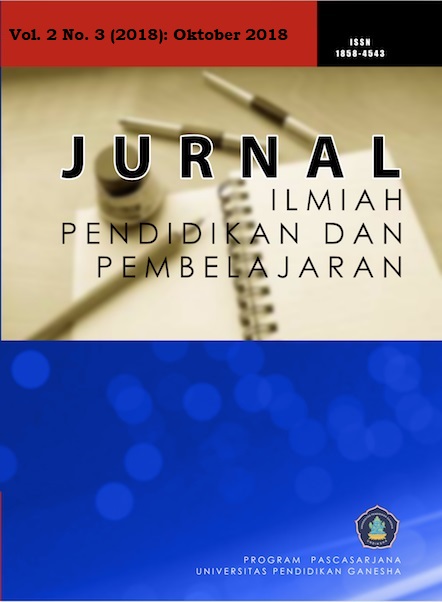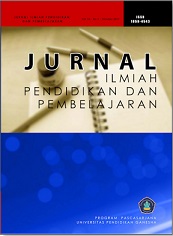PENERAPAN PROJECT BASED LEARNING BERBANTUAN REWARD UNTUK MENINGKATKAN AKTIVITAS DAN PRESTASI BERKARYA SENI GRAFIS SISWA
DOI:
https://doi.org/10.23887/jipp.v2i3.16225Abstrak
This research is a classroom action research which aims to (1) to increase student activity of class IX.3 SMP Negeri 2 Singarajain even semester of academic year 2017/2018 through implementation of reward-assisted project based learning, and (2) to increase the activity of students of class IX.3 SMP Negeri 2 Singarajain even semester of academic year 2017/2018 in producing graphic arts trough the implementation of Reward-assisted Project Based Learning. The research subjects of this action are the students of class IX.3 SMP Negeri 2 Singarajaat Academic Year 2017/2018 with total number of 36 students. This Class Action Research Design (PTK) follows the model of Stephen Kemmis conducted in two cycles. Each cycle is held in three or two meetings with each meeting 2 X 40 minutes and 1 X 40 minutes. This research data was collected by observation sheet and project test. The collected data were analyzed descriptively qualitative and quantitative descriptive. The result of the research shows that (1) the Implementation of Reward-assisted Project Based Learning can increase the students 'activity in graphic arts learning. Before the action, the students' activity is quite active, the cycle I is still quite active (52%) and in cycle II is more active (89%), (2) the Implementation of Reward-assisted Project Based Learning can improve the achievement of graphic art work. Before the average score cycle is 69.00 (36% completeness). After the action in the first cycle achievement works graphic arts students average score of 75.36 (mastery 53%), while in the second cycle average score of 84.58 (92% completeness). Keywords: Project Based Learning, Reward, Activity, Activity, AchievementLearningReferensi
Agus Suprijono, 2010. Cooperatif Learning Teori dan Aplikasi PAIKEM. Yogyakarta: Pustaka Pelajar.
Ali, M. 1992. Guru dalam Proses Belajar Mengajar. Bandung: Sinar Baru
Andayani, dkk. 2009. Pemantapan Kemampuan Profesional. Jakarta: Universitas Terbuka.
Arikunto, Suharsimi. 1989. Prosedur Penelitian. Jakarta: Bina Aksara.
BSNP. 2007. Standar Proses untuk Satuan Pendidikan Dasar dan Menengah. Jakarta: Kemendiknas
Dani Maulana, 2014Model-Model Pembelajaran Inovatif, Lampung, Lembaga Penjaminan Mutu Pendidikan Provinsi Lampung, h. 5.
Darmawan, Budiman, 1984. Pendidikan Seni Rupa. Bandung : Ganeca Exact.
Gibson, et al., 1997, Organisasi, Perilaku, Struktur dan Proses, Jakarta Erlangga, hal. 172.
Heru Purwanto, dkk, 2004 . Pendidikan Seni. Jakarta. Ganeca Exact.
Ichtiar Baru Van Hoeve, 1980 . Ensiklopedi Indonesia, Jakarta.
I Wayan Eka Mahendra, Project Based Learning bermuatan etnomatematika dalam pembelajar matematika,jurnal kreatif vol. 6 No 1 P-ISSN: 2303-288X E-ISSN: 2541-72007, h. 109
Jusuf Irianto, 2001, Manajemen Sumber Daya Manusia, Surabaya, Insan Cendekia, hal. 67.
Kurniawan Saefullah, 2009, Pengantar Manajemen, Jakarta, Kencana Prenada Media Group, hal. 248-249.
Muhaimin. H, Dkk. 2008. Pengembangan Model Kurikulum (KTSP) pada Sekolah dan Madrasah. Jakarta: PT. Raja Grafindo Persada.
Muslich, Masnur. 2008. KTSP (Kurikulum Tingkat Satuan Pendidikan) Dasar Pemahaman dan Pengembangan. Jakarta: Bumi Aksara.
Poerwadarminta, WJS, 1976. Kamus Umum Bahasa Indonesia. PN Balai Pustaka, Jakarta.
Pusat Bahasa. 2008. Kamus Besar Bahasa Indonesia Pusat Bahasa, Edisi Keempat. Jakarta: Departemen Pendidikan Nasional.
Ridwan Abdullah Sani, 2014Pembelajaran Saintifik Kurikulum 2013, Jakarta, PT. Bumi Aksara,), h. 178-179
Roestiyah, N.K. 2001. Strategi Belajar Mengajar. Jakarta: Rineka Cipta
Santyasa. 2006. Penelitian Tindakan Kelas: Konsep dasar, Teknik Penyusunan Proposal, dan Sistematika Laporan Penelitian (makalah). Singaraja: Universitas Pendidikan Ganesha
Sharon E. Smaldino, Deboran L Lowther, James D, Russel, 2011, Intrucsional Technilogy & Media For Learning Teknologi Pembelajaran dan Media untuk Belajar, Kencana , Jakarta.
Sondang P. Siagian, 1995, Manajemen Sumber Daya Manusia, Jakarta, Bumi Aksara, hal. 169.
Sugiyanto, S.Pd, dkk, 2000. Kerajinan Tangan dan Kesenian Untuk SLTP 1,2,3,
Erlangga. Jakarta.
Suharsimi Arikunto, 1993Manajemen Pengajaran, Jakarta. PT Rineka Karya, hal. 160.
Suherman, M. 2008. Model Belajar dan Pembelajaran Berorientasi Kompetensi Siswa.
Trianto, 2012, Model Pembelajaran Terpadu: Konsep, Strategi, dan Implementasinya dalam Kurikulum Tingkat Satuan Pendidikan (KPS), Jakarta, Bumi Aksara,).
Wardani, I G A K, dkk. 2008. Penelitian Tindakan Kelas. Jakarta: Universitas Terbuka.
Winarta, I Gusti, 1984. seni Rupa Untuk SMP kelas 1,2,3.
Zainal Aqib, 2013, Model-Model, Media dan Strategi Pembelajaran Kontekstual (inovatif), Bandung, CV Yrama Widya, h. 66.
Unduhan
Diterbitkan
Cara Mengutip
Terbitan
Bagian
Lisensi
Authors who publish with the Jurnal Ilmiah Pendidikan dan Pembelajaran (JIPP) agree to the following terms:
- Authors retain copyright and grant the journal the right of first publication with the work simultaneously licensed under a Creative Commons Attribution License (CC BY-SA 4.0) that allows others to share the work with an acknowledgment of the work's authorship and initial publication in this journal.
- Authors are able to enter into separate, additional contractual arrangements for the non-exclusive distribution of the journal's published version of the work (e.g., post it to an institutional repository or publish it in a book), with an acknowledgment of its initial publication in this journal.
- Authors are permitted and encouraged to post their work online (e.g., in institutional repositories or on their website) prior to and during the submission process, as it can lead to productive exchanges, as well as earlier and greater citation of published work. (See The Effect of Open Access)










